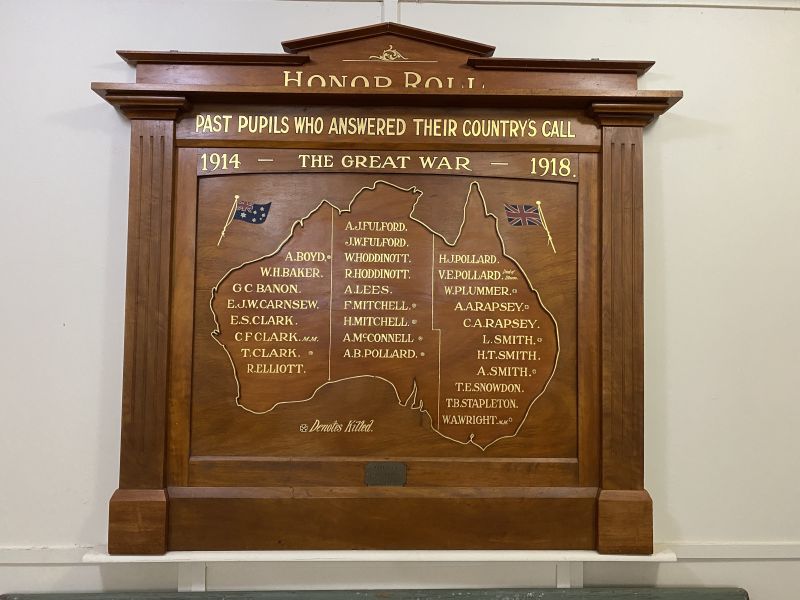Alfred (Alf) Boyes Pollard
Alf was the eldest son of Joseph and Anne (née Boyes). His family consisted of two other siblings, Sarah and Frances, and a half-brother, Charles, from his father’s previous marriage. He attended Bonegilla State School and went to the local Methodist Church.
Alf enlisted with his cousin Herb on the 4th of March 1916 at Wangaratta. He was single, 19 years old and working on the family farm. His Regimental Number was 660 and he was placed in B Company of the 37th Battalion.
While he was undergoing his training at Seymour, Alf was hospitalised with influenza for a period of four days. He embarked from Melbourne on board HMAT A34 Persic on the 3rd of June 1916, disembarking at Plymouth, England, on the 26th of July 1916.
Upon arriving in France Alf was detached for duty with the 3rd Division Traffic Police on the 29th of November. He would remain with this unit for five months, rejoining the 37th Battalion in late April of 1917. Alf’s return was noted by another Bonegilla boy, Lance-corporal Wright who wrote home to his family; “Alf Pollard had to rejin his unit with us again. He is well and I am pleased he is back again.”
The battalion’s first offensive was the Battle of Messines on the 7th of June when they attacked over ground near Plegstreet Wood. Casualties were suffered from enemy shelling in the approach to the frontline. On the 13th of June he suffered a mild gunshot wound to his face. He was transferred to the Hospital Ship West Australian and sent back to England to be admitted to Lewisham Military Hosital. After two weeks furlough he reported to the training depot at Perham Downs. He finally rejoined his battalion in France on the 31st of August 1917.
The battalion would fight in another two major actions in early October. The first was Broodseinde on the 4th of October and the second was Passchendale on the 12th of October. Alf was reported to have been wounded in action in the later.
After receiving very little information with regards to his son’s wounds, Joseph wrote to Base Records in Melbourne for further information. His query prompted some investigative work in France. It was noted in his Casualty Form - Active Service (which listed all of a soldier’s movements) that he had been seen by members of his company wounded in the field but that no information had been received from any hospitals or Casualty Clearing Stations.
Back in Bonegilla in January of 1918, Joseph and Annie had received reports from soldiers who had written from the front that Alf had been wounded in action. A family friend making inquiries in England had been told that the Army was aware that Alf had been wounded but had no information as to what hospital he was in. On the 18th of February of that year, Alf’s status was changed from “wounded and missing” to “killed in action”. Two and a half months later, Joseph received a letter from Base Records in Melbourne stating that Alf had been buried 250 yards north of Hamburg, approximately 2.5 miles north of Polygon Wood and 1.5 miles south-west of Passchendaele.
In May of 1918, the Red Cross began interviewing soldiers from the 37th Battalion who may have known something of Alf’s movements. Private T.B. Knight of 8 Platoon, B Company, 37th Battalion, described what he had seen.
“He was in B Co. VIII Pltn. I know him well, his number is 660. We came over together originally with the Battn leaving Melbourne on the 3rd June 1916. On the 12th Octr we were attacking at Passchendaele, about 2 p.m., we got up to our objective and then had to retire, fell back a certain way, and held the position. I was a S/B [stretcher bearer] on my way out with a wunded man. I came across Pollard lying on the ground. He seemed very bad. We got to the D/Station [dressing station], and then we returned to fetch Pollard in. We could not find him. He could not have been taken prisoner; we held the ground. I was wounded the same day. When I was in hospital in England, I heard from Corporal Dyson of the 37th Battn B.Co VIII Pltn, early in November, he told me that Pollard had got down to the F.A.P. [forward aid post] and apparently nothing was heard of him after that date.”
Alf’s grave was lost in the fighting of 1918. He has no known grave but is commemorated on Panel 25 of the Ypres (Menin Gate) Memorial. He is also remembered on the Australian War Memorial Roll of Honour, the Bonegilla State School Roll of Honour and his parent’s headstone at the Wodonga Cemetery. For his service during the First World War, he was awarded the British War Medal and the Victory Medal.

 Stephen Learmonth
Stephen Learmonth